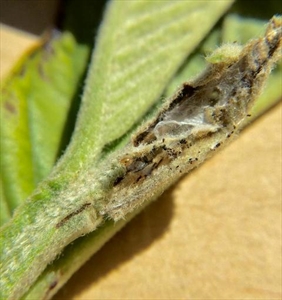- Restricted. In Oceania, Australia, Fiji, French Polynesia, New Zealand, Northern Mariana Islands, Samoa. Hosts are guavas, Malaya apple - members of Myrtle family.
- Damage: larvae roll and web shoots and kill them; also eat skin of the fruit; larvae are yellowish below and grey above; head yellowish-brown. Adult, greyish brown forewings with speckling, pale brown fringed hindwings. Serious in guava plantations.
- Natural enemies: none reported, but wasp parasitoids are likely.
- Cultural control: use finger and thumb to squash and kill larvae; plant flowering plants inside and around plantations to attract natural enemies.
- Chemical control: biorational pesticides (i) botanicals (chillies, neem, derris, pyrethrum); (ii) microbials e.g., spinosad, Bt (Bacillus thuringiensis subspecies kurstaki) against young caterpillars; (iii) synthetic insecticides are registered on guava, e.g., malathion (USA), carbaryl, dimethoate (Australia), but are best avoided as they will destroy natural enemies. Spot-spray damaged shoots rather than 'blanket' spray.








